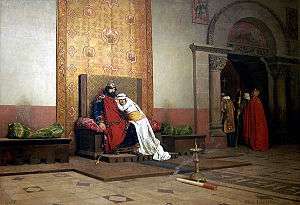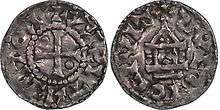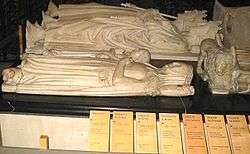Robert II of France
| Robert II the Pious | |
|---|---|
 The Excommunication of Robert the Pious by Jean-Paul Laurens (1875) | |
| King of the Franks | |
| Co-reign Solo-reign |
30 December 987 – 24 October 996; 24 October 996 – 20 July 1031 |
| Coronation | 30 December 987[1] |
| Predecessor | Hugh |
| Successor | Henry I |
| Born |
27 March 972 Orléans, France |
| Died |
20 July 1031 (aged 59) Melun, France |
| Burial | Saint Denis Basilica, Paris, France |
| Spouse |
Rozala of Italy Bertha of Burgundy Constance of Arles |
| Issue |
Hedwig, Countess of Nevers Hugh Magnus Henry I of France Adela, Countess of Flanders Robert I, Duke of Burgundy |
| House | House of Capet |
| Father | Hugh Capet |
| Mother | Adelaide of Aquitaine |
Robert II (27 March 972 – 20 July 1031), called the Pious (French: le Pieux) or the Wise (French: le Sage), was King of the Franks from 996 until his death. The second reigning member of the House of Capet, he was born in Orléans to Hugh Capet and Adelaide of Aquitaine.
Co-rule with father

Immediately after his own coronation, Robert's father Hugh began to push for the coronation of Robert. "The essential means by which the early Capetians were seen to have kept the throne in their family was through the association of the eldest surviving son in the royalty during the father's lifetime," Andrew W. Lewis has observed, in tracing the phenomenon in this line of kings who lacked dynastic legitimacy.[2] Hugh's claimed reason was that he was planning an expedition against the Moorish armies harassing Borrel II of Barcelona, an invasion which never occurred, and that the stability of the country necessitated a co-king, should he die while on expedition.[3] Ralph Glaber, however, attributes Hugh's request to his old age and inability to control the nobility.[4] Modern scholarship has largely imputed to Hugh the motive of establishing a dynasty against the claims of electoral power on the part of the aristocracy, but this is not the typical view of contemporaries and even some modern scholars have been less sceptical of Hugh's "plan" to campaign in Spain.[5] Robert was eventually crowned on 25 December 987.[6] A measure of Hugh's success is that when Hugh died in 996, Robert continued to reign without any succession dispute, but during his long reign actual royal power dissipated into the hands of the great territorial magnates.
Robert had begun to take on active royal duties with his father in the early 990s. In 991, he helped his father prevent the French bishops from trekking to Mousson in the Kingdom of Germany for a synod called by Pope John XV, with whom Hugh was then in disagreement.
Marital problems
As early as 989, having been rebuffed in his search for a Byzantine princess,[7] Hugh Capet arranged for Robert to marry Rozala, the recently widowed daughter of Berengar II of Italy, many years his senior, who took the name of Susanna upon becoming Queen.[8] She was the widow of Arnulf II of Flanders, with whom she had two children. Robert divorced her within a year of his father's death in 996. He tried instead to marry Bertha, daughter of Conrad of Burgundy, around the time of his father's death. She was a widow of Odo I of Blois, but was also Robert's cousin. For reasons of consanguinity, Pope Gregory V refused to sanction the marriage, and Robert was excommunicated.[9] After long negotiations with Gregory's successor, Sylvester II, the marriage was annulled.

Finally, in 1001, Robert entered into his final and longest-lasting marriage to Constance of Arles, the daughter of William I of Provence. Her southern customs and entourage were regarded with suspicion at court. After his companion Hugh of Beauvais urged the king to repudiate her as well, knights of her kinsman Fulk III, Count of Anjou had Beauvais murdered. The king and Bertha then went to Rome to ask Pope Sergius IV for an annulment so they could remarry.[10] After this was refused, he went back to Constance and fathered several children by her. Her ambition alienated the chroniclers of her day, who blamed her for several of the king's decisions. Constance and Robert remained married until his death in 1031.
Piety
Robert was a devout Catholic, hence his sobriquet "the Pious." He was musically inclined, being a composer, chorister, and poet, and made his palace a place of religious seclusion where he conducted the matins and vespers in his royal robes. Robert's reputation for piety also resulted from his lack of toleration for heretics, whom he harshly punished. He is credited with advocating forced conversions of local Jewry. He supported riots against the Jews of Orléans who were accused of conspiring to destroy the Church of the Holy Sepulchre in Jerusalem.[11] Furthermore, Robert reinstated the Roman imperial custom of burning heretics at the stake.[12]
Military career
The kingdom Robert inherited was not large, and in an effort to increase his power, he vigorously pursued his claim to any feudal lands that became vacant, usually resulting in war with a counter-claimant. In 1003, his invasion of the Duchy of Burgundy was thwarted, and it would not be until 1016 that he was finally able to get the support of the Church to be recognized as Duke of Burgundy.
The pious Robert made few friends and many enemies, including his own sons: Hugh, Henry, and Robert. They turned against their father in a civil war over power and property. Hugh died in revolt in 1025. In a conflict with Henry and the younger Robert, King Robert's army was defeated, and he retreated to Beaugency outside Paris, his capital. He died in the middle of the war with his sons on 20 July 1031 at Melun. He was interred with Constance in Saint Denis Basilica and succeeded by his son Henry, in both France and Burgundy.
Children

Robert had no children from his short-lived marriage to Susanna. His illegal marriage to Bertha gave him one stillborn son in 999, but only Constance gave him surviving children:
- Hedwig (or Advisa), Countess of Auxerre (c. 1003 – after 1063), married Renauld I, Count of Nevers[13] on 25 January 1016 and had issue.
- Hugh Magnus, co-king (1007 – 17 September 1025)
- Henry I, successor (4 May 1008 – 4 August 1060)
- Adela, Countess of Contenance (1009 – 5 June 1063), married (1) Richard III of Normandy and (2) Count Baldwin V of Flanders.
- Robert (1011 – 21 March 1076)
- Odo or Eudes (1013–c.1056), who may have been intellectually disabled and died after his brother's failed invasion of Normandy
- Constance (1014–1052), married Count Manasses de Dammartin.
Robert also left an illegitimate son: Rudolph, Bishop of Bourges.
Ancestry
| Ancestors of Robert II of France | |||||||||||||||||||||||||||||||||||||||||||||||||||||||||||||||||||||||||||||||||||||||||||||||||||||||||||||||||||||||||||||||||||||||||||||||||||||||||||||||||||||||||||||||||||||||||||||||||||||||||||||||||||||||||||||||||||||||||||||||||||||||||||||||||||||||||||||||||||||||||||||||||||||||||||||||||||||||||||||||||||||||||||||||||||||||||||||||||||||||||||||||||||||||||||||||||||||||||||||||||||||||||||||||||||||||||||||||||||||||||||||||||||||||||||
|---|---|---|---|---|---|---|---|---|---|---|---|---|---|---|---|---|---|---|---|---|---|---|---|---|---|---|---|---|---|---|---|---|---|---|---|---|---|---|---|---|---|---|---|---|---|---|---|---|---|---|---|---|---|---|---|---|---|---|---|---|---|---|---|---|---|---|---|---|---|---|---|---|---|---|---|---|---|---|---|---|---|---|---|---|---|---|---|---|---|---|---|---|---|---|---|---|---|---|---|---|---|---|---|---|---|---|---|---|---|---|---|---|---|---|---|---|---|---|---|---|---|---|---|---|---|---|---|---|---|---|---|---|---|---|---|---|---|---|---|---|---|---|---|---|---|---|---|---|---|---|---|---|---|---|---|---|---|---|---|---|---|---|---|---|---|---|---|---|---|---|---|---|---|---|---|---|---|---|---|---|---|---|---|---|---|---|---|---|---|---|---|---|---|---|---|---|---|---|---|---|---|---|---|---|---|---|---|---|---|---|---|---|---|---|---|---|---|---|---|---|---|---|---|---|---|---|---|---|---|---|---|---|---|---|---|---|---|---|---|---|---|---|---|---|---|---|---|---|---|---|---|---|---|---|---|---|---|---|---|---|---|---|---|---|---|---|---|---|---|---|---|---|---|---|---|---|---|---|---|---|---|---|---|---|---|---|---|---|---|---|---|---|---|---|---|---|---|---|---|---|---|---|---|---|---|---|---|---|---|---|---|---|---|---|---|---|---|---|---|---|---|---|---|---|---|---|---|---|---|---|---|---|---|---|---|---|---|---|---|---|---|---|---|---|---|---|---|---|---|---|---|---|---|---|---|---|---|---|---|---|---|---|---|---|---|---|---|---|---|---|---|---|---|---|---|---|---|---|---|---|---|---|---|---|---|---|---|---|---|---|---|---|---|---|---|---|---|---|---|---|---|---|---|---|---|---|---|---|---|---|---|---|---|---|---|---|---|---|---|---|---|---|---|---|---|---|---|---|---|---|---|---|---|---|---|---|---|---|---|---|---|---|---|---|---|---|---|---|---|---|---|---|---|---|---|---|---|---|---|
| |||||||||||||||||||||||||||||||||||||||||||||||||||||||||||||||||||||||||||||||||||||||||||||||||||||||||||||||||||||||||||||||||||||||||||||||||||||||||||||||||||||||||||||||||||||||||||||||||||||||||||||||||||||||||||||||||||||||||||||||||||||||||||||||||||||||||||||||||||||||||||||||||||||||||||||||||||||||||||||||||||||||||||||||||||||||||||||||||||||||||||||||||||||||||||||||||||||||||||||||||||||||||||||||||||||||||||||||||||||||||||||||||||||||||||
Notes
- ↑ Fulk Nerra, the neo-Roman consul, 987–1040: a political biography of the Angevin count
- ↑ Andrew W. Lewis, "Anticipatory Association of the Heir in Early Capetian France" The American Historical Review 83.4 (October 1978:906–927) p. 907; the last co-king was Philip Augustus, who was co-king to the ailing Louis VII.
- ↑ Lewis, 908.
- ↑ Lewis, 914.
- ↑ Lewis, passim.
- ↑ Robert Fawtier, The Capetian Kings of France, transl. Lionel Butler and R.J. Adam, (Macmillan, 1989), 48.
- ↑ The letter composed by Gerbert survives, though no Byzantine response is recorded: Constance B. Bouchard, 'Consanguinity and Noble Marriages in the Tenth and Eleventh Centuries" Speculum 56.2 (April 1981:268–287) pp 274, 276.
- ↑ The most complete account of the marriages of Robert II remains that of Charles Pfister, Etudes sur le règne de Robert le Pieux (Paris 1885:41–69); see Constance Bouchard 1981:273ff.
- ↑ James Palmer, The Apocalypse in the Early Middle Ages, (Cambridge University Press, 2014), 215.
- ↑ Nolan. Capetian Women. p. 13.
- ↑ The Complete Jewish Guide to France.
- ↑ MacCulloch, Diarmaid. A History of Christianity. Penguin Books, 2010, p. 396.
- ↑ Constance Brittain Bourchard, Sword, Miter, and Cloister: Nobility and the Church in Burgundy, 980-1188, (Cornell University Press, 1987), 343.
Sources
- Lewis, Andrew W. "Anticipatory Association of the Heir in Early Capetian France." The American Historical Review, Vol. 83, No. 4. (Oct., 1978), pp 906–927.
- Jessee, W. Scott. "A missing Capetian princess: Advisa, daughter of King Robert II of France". Medieval Prosopography, 1990.
- Nolan, Kathleen D. Capetian Women, 2003.
| Robert II of France Born: 27 March 972 Died: 20 July 1031 | ||
| Regnal titles | ||
|---|---|---|
| Preceded by Hugh |
King of the Franks 25 December 987 – 29 July 1031 with Hugh Capet as senior king (25 December 987 – 24 October 996) Hugh Magnus as junior king (19 June 1017 – 17 September 1026) Henry I as junior king (14 May 1027 – 29 July 1031) |
Succeeded by Henry I |
| Preceded by Otto William |
Duke of Burgundy 1004–1016 |
Succeeded by Henry I |
.svg.png)